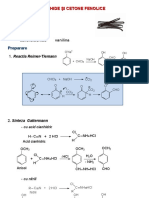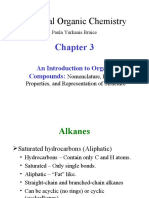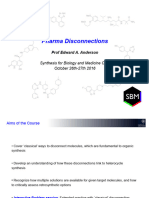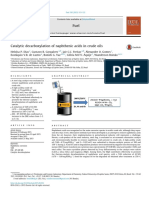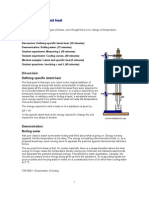100%(1)100% found this document useful (1 vote)
140 viewsSynthetic Polymers: Paula Yurkanis Bruice University of California, Santa Barbara
Uploaded by
Patil satyajitCopyright
© © All Rights Reserved
We take content rights seriously. If you suspect this is your content, claim it here.
Available Formats
Download as PPT, PDF, TXT or read online on Scribd
100%(1)100% found this document useful (1 vote)
140 viewsSynthetic Polymers: Paula Yurkanis Bruice University of California, Santa Barbara
Uploaded by
Patil satyajitCopyright
© © All Rights Reserved
We take content rights seriously. If you suspect this is your content, claim it here.
Available Formats
Download as PPT, PDF, TXT or read online on Scribd
You are on page 1/ 59
Chapter 27
Synthetic
Polymers
Paula Yurkanis Bruice
University of California,
Santa Barbara
© 2014 Pearson Education, Inc.
Polymerization
A polymer is a large molecule made by linking together repeating
units of small molecules called monomers.
© 2014 Pearson Education, Inc.
A Chain-Growth Polymer
(polystyrene)
Chain-growth polymers (also known as addition polymers),
are made by chain reactions.
© 2014 Pearson Education, Inc.
Step-Growth Polymer
(Dacron)
Step-growth polymers (also called condensation polymers), are made by
combining two molecules while removing a small molecule.
© 2014 Pearson Education, Inc.
© 2014 Pearson Education, Inc.
Chain-Growth Polymers
Chain-growth polymers are formed by one of three mechanisms.
• Radical polymerization
• Cationic polymerization
• Anionic polymerization
© 2014 Pearson Education, Inc.
Radical Polymerization
The initiator is a radical.
© 2014 Pearson Education, Inc.
Propagation Steps
© 2014 Pearson Education, Inc.
Termination Steps
© 2014 Pearson Education, Inc.
Chain Transfer
The molecular weight of the polymer can be controlled
by a process known as chain transfer.
© 2014 Pearson Education, Inc.
Head-to-Tail Linkage
Chain-growth polymerization of monosubstituted ethylenes exhibits
a marked preference for head-to-tail addition.
© 2014 Pearson Education, Inc.
Poly(vinyl chloride)
Head-to-tail addition forms a polymer with a substituent on every other carbon.
© 2014 Pearson Education, Inc.
Stabilization of the Propagating Site
Head-to-tail addition is favored for steric reasons.
Head-to-tail addition is favored by groups that stabilize radicals.
© 2014 Pearson Education, Inc.
Alkenes Used in
Radical Polymerization
© 2014 Pearson Education, Inc.
Radical Initiators
© 2014 Pearson Education, Inc.
Branching of the Polymer Chain
© 2014 Pearson Education, Inc.
Branched Polymers are More Flexible
© 2014 Pearson Education, Inc.
Recycling Symbols
© 2014 Pearson Education, Inc.
Cationic Polymerization
The initiator is an electrophile.
© 2014 Pearson Education, Inc.
Propagating Steps
© 2014 Pearson Education, Inc.
Three Ways to Terminate the Chain
© 2014 Pearson Education, Inc.
A Carbocation Monomer Can Undergo
Carbocation Rearrangement
© 2014 Pearson Education, Inc.
Alkenes Used in
Cationic Polymerization
Monomers with electron-donating substituents undergo cationic polymerization.
© 2014 Pearson Education, Inc.
Anionic Polymerization
The initiator is a nucleophile.
© 2014 Pearson Education, Inc.
Propagating Steps
Nonterminated chains are called “living polymers” and
remain active until they are “killed.”
© 2014 Pearson Education, Inc.
Alkenes Used in
Anionic Polymerization
Monomers with electron-withdrawing substituents
undergo anionic polymerization.
© 2014 Pearson Education, Inc.
Super Glue
(an example of anionic polymerization)
© 2014 Pearson Education, Inc.
What Determines the Mechanism?
Alkenes with substituents that can stabilize radicals undergo radical
polymerization.
Alkenes with electron-donating substituents that can stabilize cations
undergo cationic polymerization.
Alkenes with electron-withdrawing substituents that can stabilize
anions undergo anionic polymerization.
Some alkenes undergo polymerization by more than one mechanism.
© 2014 Pearson Education, Inc.
Ring-Opening Polymerization
(anionic)
© 2014 Pearson Education, Inc.
Ring-Opening Polymerization
(cationic)
© 2014 Pearson Education, Inc.
Stereochemistry of Polymerization
Long, unbranched polymers with either isotactic or the syndiotactic
configuration can be prepared using an aluminum–titanium initiator (a Ziegler–
Natta catalyst).
© 2014 Pearson Education, Inc.
Mechanism for
Ziegler–Natta-Catalyzed Polymerization
© 2014 Pearson Education, Inc.
Polymerization of Dienes
These rubbers have cis double bonds.
© 2014 Pearson Education, Inc.
Neoprene
(a synthetic rubber)
Neoprene has trans double bonds.
© 2014 Pearson Education, Inc.
Disulfide Bonds in Rubber
The more sulfur used in vulcanization, the more rigid the polymer.
© 2014 Pearson Education, Inc.
Four Types of Copolymers
© 2014 Pearson Education, Inc.
© 2014 Pearson Education, Inc.
Step-Growth Polymers
The monomer can have two different functional groups.
The monomer can be two different bifunctional compounds.
© 2014 Pearson Education, Inc.
Step-Growth Polymerization Requires
High Yields for Long Chains
© 2014 Pearson Education, Inc.
Nylon is a Polyamide
Nylon 6 is an example of a step-growth polymer formed by a
monomer with two different functional groups.
© 2014 Pearson Education, Inc.
Commercial Synthesis of Nylon 6
© 2014 Pearson Education, Inc.
Nylon is a Polyamide
Nylon 66 is an example of a step-growth polymer formed by two
different bifunctional monomers.
© 2014 Pearson Education, Inc.
Aromatic Polyamides are Called Aramides
The incorporation of aromatic rings into polymers improves the
physical strength of the polymers.
© 2014 Pearson Education, Inc.
Kevlar
© 2014 Pearson Education, Inc.
Dacron is a Polyester
Polyesters are step-growth polymers in which
the monomer units are joined together by ester
groups.
© 2014 Pearson Education, Inc.
Kodel is a Polyester
© 2014 Pearson Education, Inc.
Lexan is a Polycarbonate
Polycarbonates have two ester groups bonded to the same carbon.
© 2014 Pearson Education, Inc.
An Epoxy Resin is a Cross-Linked Polymer
(it is the strongest adhesive known)
© 2014 Pearson Education, Inc.
A Urethane
A urethane has an OR and an NHR bonded to the same carbonyl carbon.
© 2014 Pearson Education, Inc.
A Polyurethane
© 2014 Pearson Education, Inc.
Crystallites are Highly Ordered Regions
© 2014 Pearson Education, Inc.
The More Crystalline the Polymer is, the Denser,
Harder, and More Resistant it is to Heat
© 2014 Pearson Education, Inc.
A Thermosetting Polymer
Thermosetting polymers are cross-linked.
The greater the degree of cross-linking, the more rigid the polymer.
© 2014 Pearson Education, Inc.
An Oriented Polymer
These polymers are stronger than steel and can conduct electricity.
© 2014 Pearson Education, Inc.
A Plasticizer
A plasticizer is an organic compound that is added to a polymer to
make it more flexible.
© 2014 Pearson Education, Inc.
Recycling a Polymer
This is the reverse of the transesterification reaction that formed the polymer.
© 2014 Pearson Education, Inc.
Biodegradable Polymers
Polylactic Acid (PLA)
Biodegradable polymers can be broken into small
molecules by microorganisms.
© 2014 Pearson Education, Inc.
PLA Cannot Be Used for Hot Drinks
© 2014 Pearson Education, Inc.
Biodegradable Polymers
(polyhydroxyalkanoates)
Polyhydroxyalkanoates (PHAs) are condensation
polymers of 3-hydroxycarboxylic acids.
© 2014 Pearson Education, Inc.
You might also like
- Chapter 9: Instrumentation On BioreactorNo ratings yetChapter 9: Instrumentation On Bioreactor34 pages
- Chapter 1. Electronic Structure and Bonding Acids and Bases100% (1)Chapter 1. Electronic Structure and Bonding Acids and Bases42 pages
- Essential Organic Chemistry: An Introduction To Organic CompoundsNo ratings yetEssential Organic Chemistry: An Introduction To Organic Compounds101 pages
- Instrumental Analysis Chemistry 434L Lab Manual 2011No ratings yetInstrumental Analysis Chemistry 434L Lab Manual 201187 pages
- Chromatography: Organized By: Badahdah, M. S. & Alghazzawi, W. M. 1No ratings yetChromatography: Organized By: Badahdah, M. S. & Alghazzawi, W. M. 117 pages
- Caiet Biochimie S2: Melniciuc Maria Elena, Grupa 6202No ratings yetCaiet Biochimie S2: Melniciuc Maria Elena, Grupa 620214 pages
- Determination of Cholesterol From Egg Yolk - Expt 9No ratings yetDetermination of Cholesterol From Egg Yolk - Expt 92 pages
- Various Tools and Techniques Used For Structural ElucidationNo ratings yetVarious Tools and Techniques Used For Structural Elucidation28 pages
- Fragmentasi Myrcene: Tugas Mata Kuliah Kimia Minyak AtsiriNo ratings yetFragmentasi Myrcene: Tugas Mata Kuliah Kimia Minyak Atsiri7 pages
- Ch. 6: Chemical Equilibrium: Updated Oct. 5, 2011: Minor Fix On Slide 11, New Slides 31-42No ratings yetCh. 6: Chemical Equilibrium: Updated Oct. 5, 2011: Minor Fix On Slide 11, New Slides 31-4242 pages
- Ch-09-Molecular Geometry and Bonding TheoriesNo ratings yetCh-09-Molecular Geometry and Bonding Theories104 pages
- Catalytic Decarboxylation of Naphthenic Acids in Crude OilsNo ratings yetCatalytic Decarboxylation of Naphthenic Acids in Crude Oils9 pages
- Polymers: Lecture 3 Unit-2b: The Mechanism of Addition Polymerization100% (2)Polymers: Lecture 3 Unit-2b: The Mechanism of Addition Polymerization3 pages
- The Pyrolysis of Individual Plastics and A Plastic Mixture in A Fixed Bed ReactorNo ratings yetThe Pyrolysis of Individual Plastics and A Plastic Mixture in A Fixed Bed Reactor12 pages
- Qfi"U-Ru +) ST Inf) DRLT (Dut$,Td Ts"D$I/$') DL/ ' B ..R"U-,-Dnl L'/ - Uehk N Tudol100% (1)Qfi"U-Ru +) ST Inf) DRLT (Dut$,Td Ts"D$I/$') DL/ ' B ..R"U-,-Dnl L'/ - Uehk N Tudol9 pages
- Synthesis and Characterization of Schiff Base From Aromatic Amine and Aromatic P Nitro BenzaldehydeNo ratings yetSynthesis and Characterization of Schiff Base From Aromatic Amine and Aromatic P Nitro Benzaldehyde4 pages
- Organic Chemistry 6 Edition: Synthetic PolymersNo ratings yetOrganic Chemistry 6 Edition: Synthetic Polymers52 pages
- SSEN Testing of High Voltage Apparatus - Operational Safety Manual Section 9.1 Rev1.00No ratings yetSSEN Testing of High Voltage Apparatus - Operational Safety Manual Section 9.1 Rev1.0031 pages
- Talaibon Res. Estimate For Loan PurposesNo ratings yetTalaibon Res. Estimate For Loan Purposes2 pages
- Data Analysis For Constant Head Permeability TestNo ratings yetData Analysis For Constant Head Permeability Test3 pages
- Structural Fire Design According To EurocodesNo ratings yetStructural Fire Design According To Eurocodes56 pages
- catalog-6 mm rebar- wire mesh- wire typesNo ratings yetcatalog-6 mm rebar- wire mesh- wire types6 pages
- CT050!3!2 Web Applications - Assignment 2016No ratings yetCT050!3!2 Web Applications - Assignment 20164 pages
- Bernard Schulze - Associate Principal and Unit Manager: ExperienceNo ratings yetBernard Schulze - Associate Principal and Unit Manager: Experience1 page
- Privacy-Preserving and Truthful Detection of Packet Dropping AttacksNo ratings yetPrivacy-Preserving and Truthful Detection of Packet Dropping Attacks9 pages


